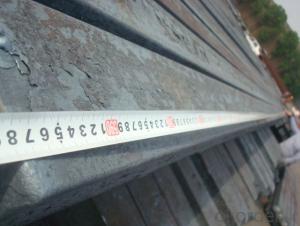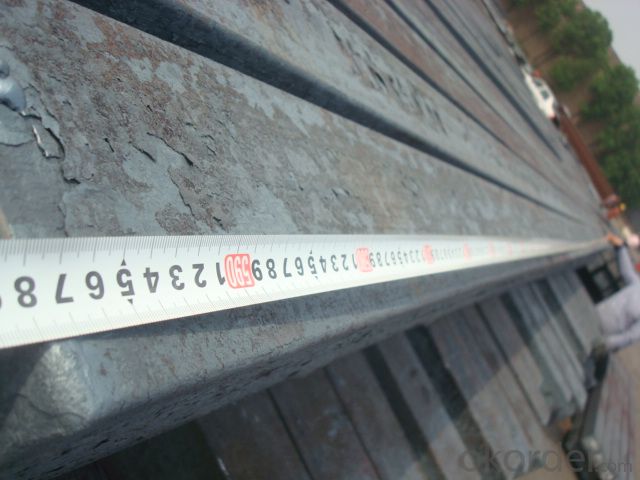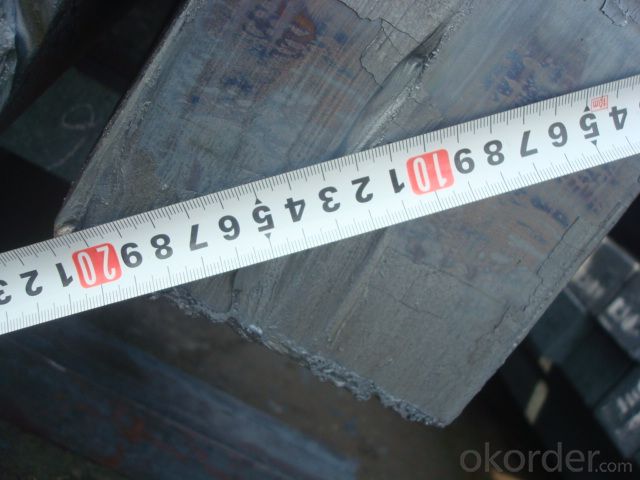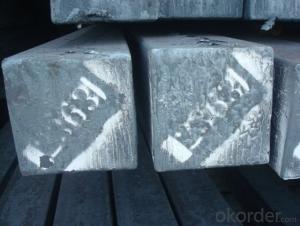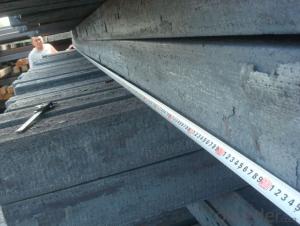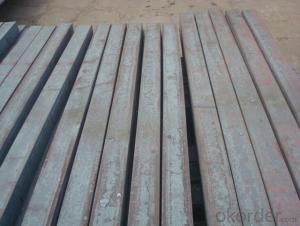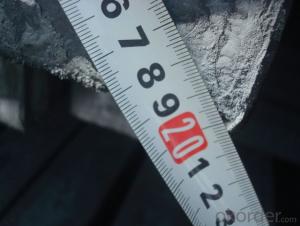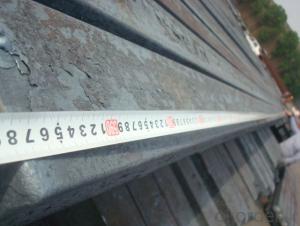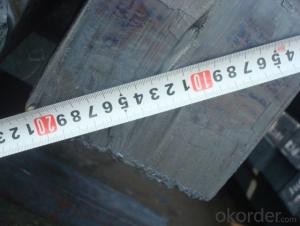Continue Casting Steel Billets/Blooms Made by Blasting Furnace
- Loading Port:
- Tianjin
- Payment Terms:
- TT OR LC
- Min Order Qty:
- 1000 m.t.
- Supply Capability:
- 100000 m.t./month
OKorder Service Pledge
OKorder Financial Service
You Might Also Like
Continue Casting Steel Billet by Blasting Furnace
1.Structure of Continue Casting Steel Billet by Blasting Furnace
Continue Casting Steel Billet by Blasting Furnace is the raw material of all kinds of steel mill. Billet section of square, round, flat, rectangular and abnormity, etc Several, mainly related to shape of rolled products. Simple rolled section steel, choose cross section of square billet or rectangular billet. rolling The sector products such as flat steel, Angle steel, select the rectangular billet or slab. Had better profiled billet when production beams, channels, and in rolling process Lines and improve the yield. The raw material of round billet is the production of seamless tube.
2.Main Features of Continue Casting Steel Billet by Blasting Furnace.
Continue Casting Steel Billet by Blasting Furnace section size should meet the requirements of rolling deformation and finished product quality, but also roll strength and biting condition of restrictions. General steel Billet section height H. And the roll diameter D The ratio of the ( namely H/D) Should be less than or equal to zero 0.5 . Length of steel billet by finishing temperature, Rolling time and the length of the product Or times ruler. When heated too long accident prone to bump the furnace wall of steel, too short, furnace bottom utilization rate is not high, influence the heating furnace production. For the production Choose a variety of steel and steel billet, should consider the affinities of billet, as far as possible in order to improve the productivity of the roughing mill, simplify the stock management of workshop.
There are three shapes of the steel billets: square billet, slab, rectangular billet The Chinese billet, rectangular billet is mainly suitable for rolling hot rolled strip, building reinforced bar, Ordinary wire, high speed wire rod and various small profile. Of the slab are mainly used for rolling plate and hot coil sheet.
3. Continue Casting Steel Billet by Blasting Furnace Images

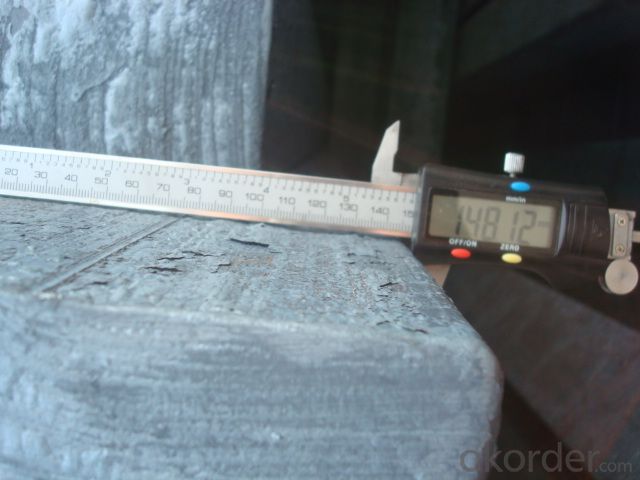
4. Continue Casting Steel Billet by Blasting Furnace Specification
Continue Casting Steel Billet by Blasting Furnace rolled steel, after processing can be used for mechanical parts, forging parts, processing all kinds of steel, steel Q345B channel steel, wire rod is the role of the billet. Steel billet is used in the production of semi-finished products, generally cannot be used directly for the society. Steel billets and steel are strictly divided into standard, cannot decide to whether the business enterprise of the final product, and according to unified standards to perform the whole society. Typically, billet and the steel is relatively easy to distinguish, but for some steel billet, and have the same specification and same steel purposes (such as rolling tube billet), whether can be used for other industries, whether through steel processing process, whether through a finished product rolling mill processing to distinguish
Material standard The editor Range of thickness: 150-240 - mm + / - 5 mm width range: 880-1530 - mm + / - 20 mm Length: 3700-10000 - mm + / - 500 - mm Cross-sectional size: 64 * 64; 82 * 82; 98 * 98; 124 * 124; 120 * 150; 152 * 164; 152 * 170 mm Length: 9000 mm Section of tolerance: billet: 1.0 + / - 2.0-1.0 + / - 1.0 mm slab: width: + / - 2.0 mm thickness: + / - 3.0 mm The length tolerance: + / - 200 mm Section diagonal tolerance: 3.5-8.0 MM Billet section size protrusions requirements: < 1242 mm, do not allow; > = 1242 mm, < = 2 mm 1242 mm, < = 3 mm Beheading (shear) extension deformation: < 1242 mm billet: no control; The slab: < = 15 mm Surface tilt: no more than billet section 0.1 Bending: every 1 m length is not more than 10 mm The distortion: length < = 5 m, < = 11. ; The length of the < = 7.5 M, < = 5. Material % 3 sp/PS chemical composition: C Mn Si S P
5.FAQ of Continue Casting Steel Billet by Blasting Furnace
We have organized several common questions for our clients,may help you sincerely:
①How about your company?
A world class manufacturer & supplier of castings forging in carbon steel and alloy steel,is one of the large-scale professional investment casting production bases in China,consisting of both casting foundry forging and machining factory. Annually more than 8000 tons Precision casting and forging parts are exported to markets in Europe,America and Japan. OEM casting and forging service available according to customer’s requirements.
②How to guarantee the quality of the products?
We have established the international advanced quality management system,every link from raw material to final product we have strict quality test;We resolutely put an end to unqualified products flowing into the market. At the same time, we will provide necessary follow-up service assurance.
③What are the types of non-metallic inclusions in continuous casting billet? The non-metallic inclusions in continuous casting billet, according to the generated methods can be divided into endogenous inclusions and exotic inclusions. Endogenous inclusions, mainly is pointed out that steel, ferroalloy products and pouring molten steel and air secondary oxidation in the process of product, such as aluminum oxide. Foreign inclusions, mainly to the inclusion of smelting and casting process, such as the erosion of ladle, tundish refractory, involved in the package of slag and protecting slag, shuikou washed residue, etc. The final solidification in continuous casting billet size, quantity and distribution of inclusions and is affected by the purity of molten steel in tundish, the impact of the mold injection flow depth and the movement state of the flow injection etc.For curved continuous caster, from intrados 1/4 thickness in inclusions have gathered phenomenon, this is a serious defect.Electromagnetic stirring can control the movement of molten steel in mould, and exclusion of inclusions, therefore we have to be serious study of the production of impurity and motion law.
- Q: How are steel billets inspected for internal defects?
- Various non-destructive testing (NDT) techniques are utilized to inspect steel billets for internal defects. Ultrasonic testing (UT) is a common method wherein high-frequency sound waves are employed to detect flaws within the billet. By sending ultrasonic waves into the billet and analyzing the reflected waves, any internal flaws can be identified. UT has the capability to detect defects such as cracks, voids, inclusions, and other irregularities. Another technique used is magnetic particle inspection (MPI), which is particularly effective for identifying surface and near-surface defects in ferromagnetic materials like steel. By applying a magnetic field to the billet and spreading iron particles over its surface, any defects will cause the particles to form visible indications, thereby providing a clear indication of internal flaws. Liquid penetrant testing (PT) is another widely employed method for inspecting steel billets. This process involves applying a liquid dye to the billet's surface and allowing it to penetrate any surface-breaking defects. After a designated time, excess dye is removed and a developer is applied. The developer draws out the penetrant from any defects, making them visible under suitable lighting conditions. Furthermore, radiographic testing (RT) can be utilized to detect internal defects in steel billets. This method utilizes X-rays or gamma rays to capture images of the billet's internal structure. As the radiation passes through the billet, a film or digital detector records the transmitted radiation. Any internal defects will appear as shadows on the image, facilitating their identification. In summary, a combination of these NDT techniques is often employed to ensure a comprehensive inspection of steel billets for internal defects. This aids in maintaining the quality and integrity of the billets, ensuring they meet the necessary specifications and standards.
- Q: Can steel billets be used in the production of kitchenware?
- Kitchenware can indeed be made using steel billets. Steel billets, which are essentially unfinished steel products that have been cast into a rectangular shape, can undergo further processing through methods such as forging, rolling, or extrusion. These processes allow for the creation of a wide range of kitchenware items, including pots, pans, utensils, and cutlery. The use of steel in kitchenware production is popular due to its exceptional strength, durability, and resistance to heat. It is also well-known for its ability to resist corrosion, making it safe for contact with food and liquids. Furthermore, steel is easy to clean and maintain, making it a hygienic choice for kitchenware. The typical manufacturing process involves heating and shaping the steel billets into the desired form, followed by finishing processes like polishing or coating to improve both the aesthetics and functionality of the kitchenware. With the versatility to produce kitchenware in various shapes, sizes, and designs, steel billets provide a flexible solution for creating high-quality and long-lasting kitchenware items.
- Q: What are the cost implications of using steel billets in manufacturing?
- The cost implications of using steel billets in manufacturing can vary depending on several factors. Firstly, the price of steel billets themselves can fluctuate due to market conditions and supply and demand. Additionally, the cost of transportation and logistics to acquire and transport the billets to the manufacturing facility can impact overall expenses. Moreover, the processing and fabrication techniques required to convert the billets into finished products may incur additional costs, such as labor, energy, and equipment expenses. Furthermore, the quality and characteristics of the steel billets, including their composition, size, and surface finish, can also influence costs. Ultimately, careful consideration of these factors is necessary to assess the cost implications accurately.
- Q: What are the different packaging options available for steel billets?
- There are several packaging options available for steel billets, including wooden crates, steel frames, and bundles with steel straps. These packaging options provide protection during transportation and storage, ensuring the integrity and quality of the steel billets.
- Q: How are steel billets used in the production of transmission components?
- Steel billets are used in the production of transmission components as they serve as the raw material that is shaped, machined, and formed into various parts such as gears, shafts, and casings. These billets are heated, forged, and then processed through cutting, grinding, and milling operations to create the desired shape and size for each component. The strength and durability of steel make it an ideal material for transmission components, ensuring reliable and efficient operation in vehicles and machinery.
- Q: What is the typical impact strength of a steel billet?
- The typical impact strength of a steel billet varies depending on the specific grade and composition of the steel. In general, steel billets exhibit a high level of toughness and can withstand significant impact forces without fracturing or breaking. This is due to the inherent strength and ductility of steel as a material. However, it is important to note that the impact strength of a steel billet can be further enhanced through various processes such as heat treatment or alloying. These processes can help improve the material's resistance to impact, making it even more durable and suitable for demanding applications. Ultimately, it is crucial to consider the specific grade and composition of the steel billet in order to determine its exact impact strength. Different steel grades are designed for different purposes, and their impact strength can vary accordingly. Therefore, it is recommended to consult the manufacturer or refer to the material specifications to obtain accurate and detailed information regarding the typical impact strength of a particular steel billet.
- Q: What are the advantages of using steel billets in the manufacturing process?
- Using steel billets in the manufacturing process offers numerous benefits. Firstly, the controlled casting process used to produce steel billets ensures superior quality and consistent material. This consistency is essential in manufacturing applications that demand precise dimensions and mechanical properties. Secondly, steel billets possess remarkable strength and durability, making them suitable for a wide range of manufacturing purposes. Steel is renowned for its high tensile strength, enabling it to withstand heavy loads and impacts without any deformation or failure. As a result, steel billets are ideal for structural components and machinery parts that must endure high levels of stress. Moreover, steel billets can be easily shaped and formed into various sizes and shapes to meet specific design requirements. Manufacturers can achieve the desired shape by hot rolling, cold rolling, or forging the billets. This flexibility allows for the creation of intricate and complex parts with ease. Additionally, steel billets have exceptional resistance to heat and corrosion. This makes them highly suitable for applications involving high temperatures or exposure to harsh environments, such as automotive components, construction materials, and industrial machinery. Furthermore, steel billets are readily available and cost-effective compared to alternative materials. Steel is one of the most widely produced and recycled materials globally, ensuring a consistent supply and competitive prices. This availability and affordability make steel billets the preferred choice for many manufacturers. Lastly, steel billets are environmentally friendly. The recyclability of steel helps reduce energy consumption and greenhouse gas emissions during the manufacturing process. Choosing steel billets enables businesses to minimize their environmental impact and make sustainable choices. In conclusion, the advantages of using steel billets in the manufacturing process include their superior quality and consistency, exceptional strength and durability, versatility in shaping, resistance to heat and corrosion, availability and cost-effectiveness, and environmental sustainability.
- Q: How do steel billets contribute to the manufacturing of furniture and fixtures?
- Steel billets are used in the manufacturing of furniture and fixtures as they serve as a raw material for various processes such as forging, casting, and extrusion. They can be shaped and molded into different components, such as frames, legs, and supports, which provide strength, durability, and stability to the furniture and fixtures. Additionally, steel billets can be further processed to create different finishes, such as powder coating or painting, to enhance the aesthetic appeal of the final products.
- Q: What are the main factors affecting the dimensional stability of steel billets?
- The dimensional stability of steel billets can be influenced by various factors. These factors include temperature, cooling rate, composition, mechanical stresses, heat treatment, and manufacturing techniques. Firstly, temperature plays a significant role in the dimensional stability of steel billets. Depending on the temperature they are exposed to, the billets can undergo thermal expansion or contraction. To minimize dimensional changes, it is important to carefully control the temperature during the manufacturing process and subsequent cooling stages. Secondly, the rate at which the steel billets cool down after being heated also affects their dimensional stability. Rapid cooling can result in internal stresses and cause warping or distortion, while slow cooling can lead to uneven dimensional changes. Thirdly, the chemical composition of the steel billets is a crucial factor. Different alloying elements, impurities, and carbon content can influence the behavior of the material during heating and cooling. Higher carbon content, for example, increases the likelihood of warping or distortion. Moreover, mechanical stresses from handling, transportation, or machining processes can impact the dimensional stability of steel billets. Excessive bending, twisting, or pressure can cause permanent deformation or residual stresses, thus affecting overall dimensional stability. Furthermore, the heat treatment process also plays a role in the dimensional stability of steel billets. Different heat treatment methods can introduce internal stresses or phase transformations that may alter the billet's dimensions. Lastly, the manufacturing techniques used during the production of steel billets can have an impact on their dimensional stability. Inadequate control or inconsistencies in casting, rolling, or forging processes can result in variations in the billet's dimensions. Considering and controlling these factors is crucial to ensure the dimensional stability of steel billets. Any dimensional changes can have consequences for subsequent processing steps and the overall quality of the final product.
- Q: Can steel billets be used in the production of industrial equipment?
- Yes, steel billets can be used in the production of industrial equipment. Steel billets are the raw material that can be further processed and shaped into various forms such as plates, sheets, rods, and bars. These processed steel products are commonly used in the manufacturing of industrial equipment due to their strength, durability, and suitability for machining and welding processes.
Send your message to us
Continue Casting Steel Billets/Blooms Made by Blasting Furnace
- Loading Port:
- Tianjin
- Payment Terms:
- TT OR LC
- Min Order Qty:
- 1000 m.t.
- Supply Capability:
- 100000 m.t./month
OKorder Service Pledge
OKorder Financial Service
Similar products
Hot products
Hot Searches
Related keywords
